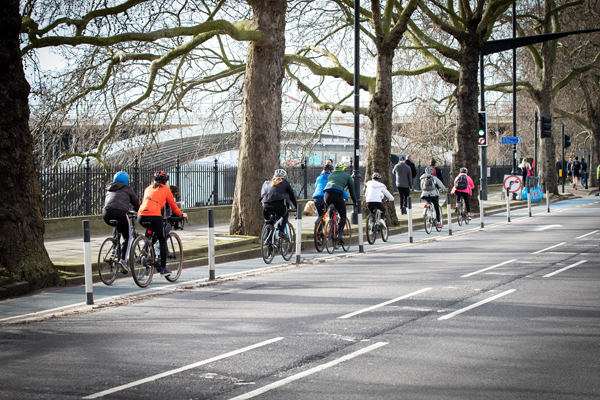Transport Network speaks to Christina Calderato, head of transport planning at Transport for London (TfL), about where its recently launched Direct Vision Standard (DVS) and permit scheme for HGVs fits in with its wider efforts to make the capital’s streets safer.
The introduction of Direct Vision is part of a wider effort by TfL to cut KSIs among vulnerable road users such as cyclists, pedestrians and motorcyclists, as well as its Vision Zero target of eliminating deaths and serious injuries from London's transport network by 2041.
In a press release around the launch of its ‘Vision Zero’ dashboard in January, TfL pointed out that people walking, cycling and motorcycling made up 81% of all people killed or seriously injured, ‘highlighting the need for urgent lifesaving measures including segregated cycle lanes, 20mph speed limits, Low Traffic Neighbourhoods, the removal of lorry blind spots and improved motorcycle training, which all aim to protect the most vulnerable on the capital's streets’.

Christina Calderato
Ms Calderato says that the introduction of the DVS, which aims to tackle HGV drivers’ blind spots through a star rating and permit system, ‘absolutely’ falls within this context.
‘At the moment, we know that more than 4,000 people are killed or seriously injured on our roads every year and can’t stand by and let that happen.
‘While we know that we are seeing a continuing decline in [those statistics], it’s not happening fast enough and we want to make sure that we can reduce the number of families that are suffering those tragedies. So we’re taking a holistic approach to reducing road danger at source, and there’s a number of ways in which we do that.
‘There’s a safer streets bit, which is where we look at the street space and the junctions, how we can make that safer. Safer speeds, which that dashboard recognises and for example we’ve made streets in Central London 20mph. [And] safer vehicles, which is where DVS comes in. That’s a really key part of tackling what we know is a really serious issue on London’s roads, so HGVs are massively over-represented in collisions and fatalities with vulnerable road users.
'Tackling that road danger at source is really key and that’s why we’re so pleased to be launching this.
‘We know that it can’t come a moment too soon; in 2021 alone three people have been killed in collisions with HGVs.’
Ms Calderato says that, although the DVS and ‘Vision Zero’ both use the same word, ‘vision', she does not feel that this risks confusing the public.
‘I think for the majority of the public, what DVS means is that we have safer lorries operating on London’s streets and that’s really visible, in terms of the difference between a five star [rated] vehicle and a zero-star vehicle.'
On the concept of Vision Zero, she says: ‘I think it is really important to set out where we want to get to because that shows the need for us taking action, radical action across the entire piece. The scale of that challenge helps demonstrate the need for action. It’s certainly not there to hide anything that we are doing in the short-term.’

TfL says major projects such as Tideway have 'led the way in introducing 5-star vehicles to London'
She adds: ‘In 2019 we saw an absolutely extraordinary fall in fatalities of cyclists. I think a 70% reduction. We were seeing an average of 17 people killed a year and in 2019 that was five cyclists killed. So the work that we are doing in terms of putting in new cycle infrastructure, segregated cycle infrastructure, that action we are taking on junctions, on streets, on speeds, is all making a difference, but if you are going to get to zero, that isn’t enough; you have to keep pushing, you have to keep doing more. ‘
In terms of engineering measures to reduce lorry blind spot incidents, particularly left-turning incidents, Ms Calderato says: ‘Through the Safer Junctions programme we are identifying the junctions that we think are problematic and we are making changes to the layout of those junctions, which will make those roads safer.’
She says reducing the roads that HGVs are allowed to use is not central to TfL’s thinking about how to reduce risks, particularly as Central London is not where the problem is.
'It’s more about looking across the piece at how we can stitch together all of these factors. Speed plays a part, vehicles play a part, location, infrastructure, behaviour.’
Transport Network raised the issue of unsegregated ‘blue paint’ cycleways such as CS8, which is currently the subject of a trial upgrade with ‘light segregation’.
(It was also the location of the death of motorcyclist Milan Dokic in 2016, after he lost control on an unsegregated blue paint section of the carriageway).
Does TfL feel it is able to go as fast as it wants to in removing unsegregated cycle lanes?
‘It’s not really about removing unsegregated cycleways; what we are trying to do is make sure that we have the appropriate infrastructure in the right places. Now, in some places, that might be segregated. In others, it doesn’t necessarily and some of our busiest routes, we see are unsegregated,' Ms Calderato says.
'So it’s not necessarily that people feel they need to use segregated cycle infrastructure. It’s absolutely about making sure that we consider the road network as a whole and what it needs to do and cater for that. And in some cases that will be segregated and in some cases, it won’t necessarily be.'

Grosvenor Road on London's CS8 cycle route has 'light segregation' under a 'trial' upgrade
'Over the past few months with the Streetspace Plan, we have put in huge amounts of cycle infrastructure and getting that in quickly and seeing how well used it has been has been eye-opening – when you create that infrastructure you see volumes of people really increasing. And that lends confidence as well, so it’s more complicated than segregated cycle infrastructure being the full answer.'
These comments appear at odds with the Department for Transport's latest guidance on cycling infrastrucure, Gear Change, which advises that 'physically segregated bike tracks on main roads, including at junctions, are the most important thing we can do to promote cycle use' and that 'cyclists must be physically separated and protected from high volume motor traffic'.
Although Gear Change states that 'side-street routes, if closed to through traffic to avoid rat-running, can be an alternative to segregated facilities or closures on main roads', many of TfL's stretches of unsegregated cycle route are on main roads.
Recently there has been both pushback from sections of public over low traffic neighbourhoods and a High Court case in which TfL’s Streetspace Plan for London was overturned, although TfL and Mayor Sadiq Khan are appealing. Are these making it harder for TfL to put in measures to protect vulnerable road users?
‘I think if you look across the Streetspace plan and the low traffic neighbourhoods, the number that are being challenged is actually incredibly small. We are disappointed with the judgement, but in the vast majority of cases, schemes have gone in and are delivering benefits.
‘What has happened is, because they were a response to the pandemic, they’ve gone in very quickly. What we want to make sure we do – and the boroughs – for future schemes is make sure we have proper time to consult and engage and the DfT has uprated their guidance, which we were really pleased to see, to build in that consultation and engagement, so we are able to spend much more time engaging with local communities to make sure that the schemes work for everyone.
‘And I think the other thing is, we need to take feedback, respond to feedback, if schemes need to be tweaked, that we tweak them.
‘Looking at those schemes [it’s about] working with communities to understand if there is a case for making them permanent, because they fit with other long-term objectives. I think we will be able to build on what’s worked well, take the good things from this process and then look at how we can use it to accelerate being able to deliver those benefits in a longer-term way with the proper engagement and consultation.’
Ms Calderato says the development of the DVS, including the introduction of a ‘safe system’ based permit for zero star vehicles and the decision to introduce it to coincide with a new Low Emission Zone scheme, is a good example of how TfL consults and engages.
She says: ‘I think that’s absolutely something that we would do on other schemes and we will be able to do again moving into this next tranche of healthy streets schemes, with that consultation and meaningful engagement with local communities.
‘It’s something we try to do all the time, but I think DVS is a good example of somewhere where we had really strong support for a scheme and by working through consultation with stakeholders, with road safety groups, with the public, we have been able to get to point where we have a world-leading direct vision standard, which will make the streets of London safer, but also beyond that, these trucks are going to be moving beyond London’s boundaries and making everywhere safer.’
Register now for full access
Register just once to get unrestricted, real-time coverage of the issues and challenges facing UK transport and highways engineers.
Full website content includes the latest news, exclusive commentary from leading industry figures and detailed topical analysis of the highways, transportation, environment and place-shaping sectors.
Use the link below to register your details for full, free access.
Already a registered? Login